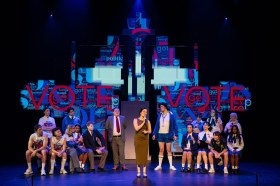When we thought we knew everything about Baby Boomers – that group aged between 58 and 75 – then think again. A new report by the independent think tank, A New Approach has been tabled this week (27 September), suggesting that Baby Boomer middle Australians offer an incredible opportunity for the arts and culture sector.
Despite being stereotyped as disinterested in art and culture, Baby Boomer middle Australians say it enriches their lives, helps them ‘stay young’, creates cross-generational connections and is a foundation for thriving, safe communities and improves mental health, reports the new study.
The study is part of a three-year research project that first looked at the Next Generation of Voters (aged 18-29), and then A View from Middle Australia (aged 35-60). ANA CEO Kate Fielding said that the common denominator across all three reports was that there is a huge appetite to engage with arts and culture.
Of this latest report – Lifelong: Perceptions of arts and culture among Baby Boomer middle Australians – she added, ‘They also told us cultural participation helps them to test opinions, negotiate and compromise, see others’ points of view and have healthy disagreements.
‘In a complicated world, it is affirming that this cohort see arts and culture as an antidote to division and a catalyst for positive conduct like open-mindedness and understanding.’
She said the report was particularly timely as Australia approaches a National Cultural Policy. Boomers are ‘the largest and most influential voting group in Australia,’ which shouts opportunity for the arts and culture sector.
Read: Reality check comes before National Cultural Policy
‘What I’d really hope is that it takes a whole of Australia approach in terms of making sure that we’re leveraging those opportunities. A National Cultural Policy should be looking at how we make sure those benefits are available?’
Why middle Australian?
‘One of the really fascinating things out of the 2021 census was, for the first time, millennials and baby boomers are equal first in terms of generational blocks [numbers],’ said Fielding. ‘That tells us how key that Baby Boomer cohort has been in Australian cultural life, and still is.’
To take that ‘real’ pulse this report has focused on people who do not work in arts and culture. ‘That was quite deliberate in trying to understand what the perceptions of this cohort, as audience members, as community members and as participants in public life, are.’
The report also turned to people who live outside our cities, and are located in suburban and regional centres.
We do a real disservice to a whole heap of Australians when we pretend that arts and culture engagement is just something that happens in the inner city.
ANA CEO Kate Fielding
‘At least a third of the population lives in regional areas, and then a huge portion in suburban Australia, so we are really tackling some of the stereotypes about who is interested in arts and culture, and who participates in arts and culture,’ Fielding told ArtsHub.
How the perception of age has changed, and impacts habits
In recent decades, our perception of the limitations of age have changed greatly, as retirement ages have been pushed back, technologies have enabled greater connection and engaged that is essentially ‘ageless’, and we have become more mobile, more opiniated, and increasingly hungry for things to do.
58 – the start of this cohort – is still very much a dynamic working, very involved age. ‘For these focus groups, about half of them were in the workforce and half of them either had left or were stepping out,’ explained Fielding.
‘So that was really deliberate; we know that this cohort is a really big range – and it captures a particular life transition. That was one of the things we were really interested to talk with this group around what role arts and culture played for them now, but also what they might be in the future or what they were seeing,’ Fielding continued.
Fielding said their findings confirmed this cohort ‘talked about how arts and culture helps them stay up to date; they use the phrase “to keep young, keep relevant”. Story after story of people talking about how they try and keep up to date with what’s happening in music, because they’re interested to understand and want to be able to talk about it with their grandkids or with their children.
‘They talked about how keeping up to date with what’s happening in culture helps them connect in the workplace. It was really fascinating in cross generational ways. Often when we think cross generational, we think family, but it’s actually also across the broader networks, professional and personal,’ said Fielding of that vital link through arts and culture.
The arts help us test opinions
A fascinating outcome of the report is how Baby Boomers value arts and culture for ‘testing opinions.’
Fielding told ArtsHub: ‘I actually find that one of the most interesting findings, to be honest. So across all three age cohorts, there’s been a theme around freedom of expression, but also expressing yourself. But the other, is also to do with the inherent value of expression – and what’s really fascinating with this cohort is they are describing how arts and culture creates a space for people and audiences to express opinions.’
While the report found that middle Australians use social media platforms to connect, they are ‘not so tapped into social media channels and platforms for sharing arts and culture,’ said Fielding, who said this cohort – unlike younger generations that want both digital engagement and face to face experiences – they still prefer face to face experiences.
COVID had a big impact on that for this age bracket. The report also took a look at barriers to participation. ‘One of the things that did come up was having a strong preference to be able to access arts and culture in their local community, because they don’t particularly like driving at night, or don’t feel safe on public transport at night. So in terms of the outer suburbs that is really interesting,’ reported Fielding.
She said that genuine wanting and concern for access was not just for themselves but for others – a kind of ‘cultural goodwill’, Fielding called it.
ANA was established in 2021 with a vision to use research and analysis to inform discussion, inspire public policy and brings together decision makers and industry leaders around pathways for pragmatic action. They are not a lobbying group.





